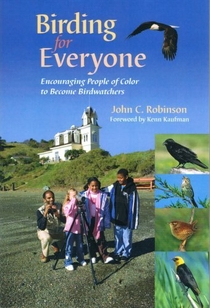Reviewed by Grant McCreary on January 10th, 2009.
To me, one of the greatest pleasures of birding is experiencing new things. New birds, obviously, but also other creatures, places, habitats, sights – all kinds of things. The diversity that I’ve encountered while birding is staggering. Well, except for one aspect. With very few exceptions, other birders that I have encountered are all of the same ethnicity. Namely, they are White. According to the results of the studies and surveys on this topic, including Robinson’s presented here, my experience has not been an aberration. Very few non-Whites are birders.
But before we consider why this is the case and what can be done about it, an even more fundamental question must be addressed: does this matter? After all, hobbies and interests are intrinsically personal. Birding, like anything else, will not necessarily appeal to everyone. However, there is one thing that sets birding apart from most other pursuits. In order for us to be able to watch birds, there must be birds to watch. Therefore, conservation should be of the utmost importance to birders. And, sadly, it needs to be important to as many people as possible for it to be a priority politically. In the not-too-distant future, Whites will not form the majority in the US. Finally, we come to the reason why it is important for people of color to be birdwatchers. They will be vital in ensuring conservation in the future, and thus the future of birding depends upon them.
Robinson starts his book by recounting how he came to be a birder and ornithologist. He was in college studying to become a wildlife biologist, and planned to study wolves. However, a required course in ornithology changed all of that. He was surprised to find that he was hooked, and knew that his destiny now revolved around birds.
The concept of birding – finding and identifying birds – is very simple. However, as with most pursuits, in reality it is a bit more complicated and daunting. The author knows that prospective birders need encouragement and assistance to get started. Thus, the next few chapters tell why one would want to study birds, what you need to get started, and tips for becoming a better birder.
In the next section, the author presents the results of his study on minorities and birding. It should be no surprise that he corroborates the observation that relatively few Blacks and other minority groups identify themselves as birders. Among other questions, the study also asked the participants what obstacles were keeping them from potentially becoming a birder. These results surprised me. I expected the lack of interest to be the most popular answer. However, the most commonly cited barrier was a lack of time (although followed by “no interest in birds”). But perhaps the most unexpected of all is that virtually all of the barriers mentioned could be removed by someone simply taking the time to introduce them to birding.
Using these results and his own experience, Robinson presents ideas that can be used to break down these barriers and expose more people to the pleasures of birding. For encouragement, and to show that it can be done, he shares some inspiring stories of some remarkable people who have done just that.
It should be clear from this overview that the two parts of this book are intended for very different audiences. The first section is geared toward new or potential birders, while the other targets individuals and, especially, organizations that can help encourage more people of color to become birdwatchers. Each section is fine on its own, but the book as a whole suffers from this jarring split focus.
But perhaps there is a way to reconcile this. Unfortunately, I don’t imagine that many new or prospective birders will find this book on their own. But hopefully clubs and individual birders will, and can share it, or at least a copy of the pertinent material, with others in order to help nudge them along the path toward birding.
Recommendation
Robinson is not exaggerating when he claims “Birding for Everyone…is about the endangerment of conservation itself”. It really is that important. Birding organizations (i.e. local and national Audubon or ornithological societies) have a responsibility to reach out to these groups underrepresented among the ranks of birders. But individuals can also have a great impact, as Robinson shows here. I would strongly urge any group or person eager to aide in this endeavor to make use of Birding for Everyone.
Disclosure: I get a small commission for purchases made through links in this post.
Disclosure: The item reviewed here was a complementary review copy provided by the publisher. But the opinion expressed here is my own, it has not been influenced in any way.



Comment